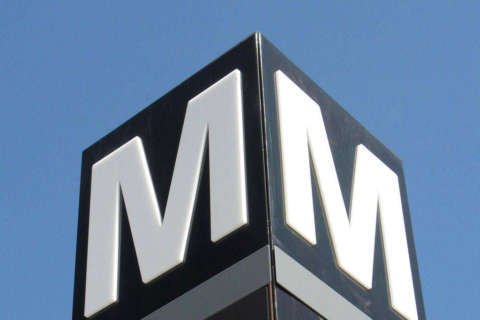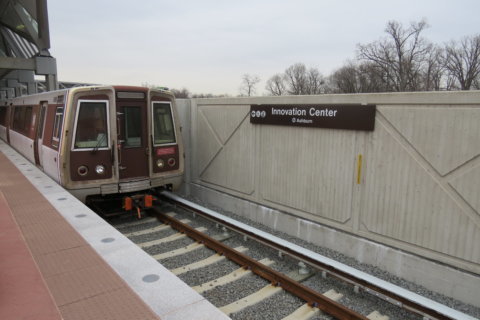It’s a few steps forward — and maybe a step or two back — toward opening the Silver Line extension to Dulles International Airport and Loudoun County, Virginia.
The stations and most of the rail yard appear to be ready to go and only await some finishing touches. New train testing started Wednesday, and fixes to other switch issues should allow new Metro trains to join the testing program next month.
However, the actual schedule for opening the line remains in dispute.
Work to link the extension to the first phase of the Silver Line has been put on hold over concerns that the changes might disrupt current Metro operations. There have already been over a dozen weekend shutdowns of the Wiehle-Reston East station.
“We did have a hiccup there where WMATA train control engineering wanted to make sure they had all the documentation that they felt necessary before CRC was allowed to load its particular software … WMATA wanted to make sure that the new software would not have any deleterious effects on the existing train control system,” said Charles Stark, vice president of the Metropolitan Washington Airports Authority, on Wednesday.
Capital Rail Constructors, the contractor building the stations and main tracks, also plans to soon complete some of the repairs for switches that were out of alignment. This would clear the way for Metro to provide 7000 Series trains for additional train control testing as soon as next month.
The company’s current schedule forecast calls for substantial completion of the stations and main tracks in June 2020.
A separate contractor building the rail yard near the airport, Hensel Phelps, projects it will have testing required for substantial completion done by August 2020.
The airports authority believes testing could be done much sooner if the companies conduct more testing simultaneously, rather than one individual eight- to 10-week phase at a time.
“We have not approved a schedule … in quite awhile. That is due to what we perceive as logic problems with the schedules that are provided,” Stark said.
He described a potential projected opening to riders in summer or fall of 2020 as “very fluid,” since they continue to work to speed up the process.
“We have not had confidence in either CRC’s or HP’s schedules that would give us the ability to accept them,” Stark said.
Both companies are working with the airports authority, Metro and Metro’s Office of the Inspector General to address concerns and timing.
“We’ve been working with MWAA about some of those sequential linear progression of the testing in order to come up with a way to hit an earlier date,” said Hensel Phelps’ Michael Barker.
The inspector general’s reviews have been much more cautious about the progress made on the line and have raised additional concerns about extra inspections that may be needed if and when Metro takes ownership of the line from the airports authority.
Additional reviews of train control inspection procedures and switch layout are underway before more train testing moves forward in the main stations and track area.
In the rail yard, a significant step in the testing process began Wednesday when Metro delivered a train to the yard, and switch issues were resolved, but work continues to sync car hoist motors and fix fire alarm communication problems identified in testing.
Metro has also promised to connect data control points in the yard to the Rail Operations Control Center by Jan. 6.
The airports authority hopes similar data control connections for the rest of the new line could be in place soon after that, particularly if they can get Metro to pay its programming consultants overtime to get everything online.
Barker said Metro and airports authority inspectors have also agreed that potential electrical issues with rail joints have been addressed, and concrete sealant work continues at the rail yard whenever temperatures are above 40 degrees.
Several areas of the rock ballast that supports the track in the rail yard need repairs, but most areas tested have met requirements.
Among ongoing punch list items, steel in the car hoist pit had to be repainted since it had been there for so long. Stark said it began to rust.
The project is well behind original schedules.
At the Dulles station, a crane brought in earlier this month was too big, so work had to be delayed.
The glass screen wall also has been redesigned to keep birds from nesting in the station.
Nearly half of the Silver Line’s construction is being paid for with tolls from the Dulles Toll Road. Earlier this month, MWAA finalized a bond issue and loan refinancing meant to reduce or eliminate toll increases after 2033.
Toll revenue is up significantly this year after a rate increase in January from $3.50 to $4.75 for a trip, including one ramp and the mainline plaza. The next toll increases are scheduled to be $6 in 2023, $7.25 in 2028 and $8.75 in 2033.
But under the nearly $1.3 billion refinancing, tolls are no longer projected to increase in 2038 to $10 or 2043 to $11.25.
A similar separate bond, issued earlier this month, reduced long-term debt at Dulles. Savings are earmarked for lowering costs for airlines.







